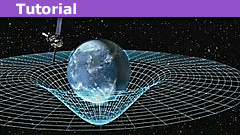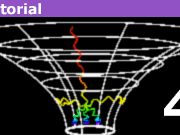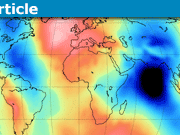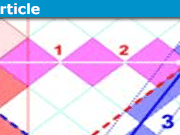Understanding Precession in Special and General Relativity
Table of Contents
The Absolute Derivative
In relativity we typically deal with two types of quantities: fields, which are defined everywhere, and particle properties, which are defined only along a curve or world line. The familiar covariant derivative is appropriate when we need to differentiate a field. A field is a function of all four coordinates, and the covariant derivative of ##\varphi(x)## consists of the four partial derivatives ##\partial \varphi /\partial x^\mu## plus correction terms involving the Christoffel symbols, one for each tensor index on ##\varphi##.
A particle property ##\varphi(s)##, on the other hand, is a function only of a single parameter ##s## running along the curve. In this situation, the partial derivatives of ##\varphi## with respect to the four coordinates do not exist. (Unfortunately many references miss this point!) Writing partial derivatives would require that ##\varphi## be defined everywhere in a neighborhood of the curve, which is not the case. The correct derivative to use for a particle property is called the absolute derivative, and is written either ##\delta\varphi / \delta s## or ##D\varphi /Ds##. Similar in form to the covariant derivative, it consists of an ordinary derivative ##d\varphi /ds## plus a correction term for each tensor index. For example, if the world line is given parametrically as ##x^\mu (s)##, the absolute derivative of a contravariant vector ##\varphi^\mu## is ##D\varphi ^\mu /Ds = d\varphi^\mu /ds + \varphi^\nu\Gamma^\mu_{\nu \sigma} dx^\sigma/ds##.
For a given timelike curve ##x^\mu (s)## we define the vector ##v^\mu = dx^\mu /ds## (note the small ##d##). This 4-vector is clearly tangent to the curve. If the parameter ##s## is chosen to measure proper time, then ##v^\mu## will be a unit vector, ##\mathbf{v}\cdot \mathbf{v} = -1##. Next we define an acceleration 4-vector ##a^\mu = Dv^\mu /Ds##. Since ##D(v_\mu v^\mu ) /Ds = 0 = v_\mu a^\mu\, , \,a^\mu## is orthogonal to ##v^\mu## and therefore lies in the instantaneous rest frame of the particle.
Fermi-Walker Transport
Given a vector ##\mathbf{W}## at a single point on the world line, we can define it at other points along the curve by specifying how it is to be propagated or transported along the curve. The simplest method is parallel transport: ##D\mathbf{W}/Ds = 0##. For example if the particle is non-accelerating, then the velocity vector is parallel-transported: ##D\mathbf{v}/Ds = 0##. But a generally more useful concept is Fermi-Walker transport. We often need to deal with a previously 3-dimensional quantity. In 4 dimensions it will be confined to the instantaneous rest frame of the particle and represented by a vector orthogonal to ##\mathbf{v}##. As the particle accelerates, the rest frame changes. Consequently for ##\mathbf{W}## to remain orthogonal it must undergo a Lorentz transformation in the ##\mathbf{v-a}## plane. The definition of Fermi-Walker transport is
$$DW^\mu /Ds = W^\nu (v^\mu a_\nu – a^\mu v_\nu)$$
Note that using F-W transport, if ## \mathbf{W \cdot v} = 0## initially, it will remain so. Physically, Fermi-Walker transport defines what we mean by a nonrotating instantaneous rest frame. To say it again, the only way ##\mathbf{W}## changes is a Lorentz boost applied in the direction of the particle’s acceleration.
The spin vector ##\mathbf{S}## is such a quantity. The fact that ##\mathbf{S}## evolves according to Fermi-Walker transport is the source of precession effects in both special and general relativity.
Precession in Flat Spacetime
Consider a particle moving in a circular orbit of radius ##r## in the equatorial plane in flat spacetime. Define a comoving orthonormal basis of 4-vectors:
\begin{align*} \mathbf{e_r}&= (\cos \omega t\, , \, \sin \omega t\, , \, 0\, , \, 0) \\ \mathbf{e_\varphi}&= (-\sin \omega t\, , \, \cos \omega t\, , \, 0\, , \, 0) \\ \mathbf{e_t}&= (0 \, , \, 0\, , \, 0\, , \, 1) \end{align*}
Thus ##\mathbf{e_r}## points radially outward, and ##\mathbf{e_\varphi}## points tangentially along the circumference.
Let ##\tau## be the particle’s proper time. Then
\begin{align*} D\mathbf{e_r} / D\tau &= \gamma\, \omega\, \mathbf{e_\varphi}\\[6pt] D\mathbf{e_\varphi} / D\tau &= -\gamma \,\omega \,\mathbf{e_r} \end{align*}
where ##\gamma = dt/d\tau##.
The particle’s position, velocity and acceleration 4-vectors are:
\begin{align*}\mathbf{x}&=r\mathbf{e_r}+t\mathbf{e_t}\\[6pt] \mathbf{v}&=D\mathbf{x} / D\tau = r\,\gamma\, \omega \,\mathbf{e_\varphi}+\gamma \,\mathbf{e_t} \\[6pt] \mathbf{a}&=D\mathbf{v} / D\tau =-\,r\,\gamma^2 \,\omega^2 \,\mathbf{e_r}\end{align*}
From this we can derive that the magnitude of the 3-velocity is ##v = r\,\omega ##, and that ##\gamma^2 = 1/(1 – r^2 \omega^2 )\,.##
Now let’s suppose that the particle carries a spin: a unit 4-vector ##\mathbf{S}## orthogonal to ##\mathbf{v}.## In general ##\mathbf{S}## can be written as some time-dependent linear combination of ##\mathbf{e_r}\, , \,\mathbf{e_\varphi}## and ## \mathbf{e_t}\,:##
\begin{align*}\mathbf{S}&=a(\tau)\mathbf{e_r}+b(\tau)\mathbf{e_\varphi}+c(\tau)\mathbf{e_t} \\[6pt] \mathbf{S\cdot v}&= 0\,\Longrightarrow \, c(\tau)=r\,\omega\,b(\tau) \\[6pt] \mathbf{S\cdot a}&= -\,r\,\gamma^2\,\omega^2\,a\end{align*}
The time derivative of ##\mathbf{S}## comes from derivatives of ##a, b, c## and also from the fact that the basis vectors ##\mathbf{e_r}\, , \,\mathbf{e_\varphi}## are rotating:
$$D\mathbf{S} / D\tau = \left( da / d\tau \,\,\mathbf{e_r} +db / d\tau \,\,\mathbf{e_\varphi} +dc / d\tau \,\,\mathbf{e_t}\right)+\left( \gamma\,\omega\,a \,\,\mathbf{e_\varphi} -\gamma \,\omega\,b \,\,\mathbf{e_r}\right)$$
Finally, this must be inserted into the Fermi-Walker transport equation:
$$D\mathbf{S} / D\tau = (\mathbf{S\cdot a})\mathbf{v} = -\,r^2\,\gamma^3\,\omega^3\,a\,\mathbf{e_\varphi} \,- \,r\,\gamma^3\,\omega^2\,a\,\mathbf{e_t}$$
and the coefficients matched:
\begin{align*}\text{ coefficients of }\mathbf{e_r}:\,\, &da / d\tau \,-\,\gamma\,\omega\,b = 0 \\[6pt] \text{ coefficients of }\mathbf{e_\varphi}:\,\, &db / d \tau\,+\,\gamma\,\omega\,a = \,-\,r^2\,\gamma^3\,\omega^3\,a \\[6pt] \text{ coefficients of }\mathbf{e_t}:\,\,&dc /d\tau = \,- \,r\,\gamma^3\,\omega^2\,a \end{align*}
Which simplify to:
\begin{align*}da/d\tau &= \,\gamma\,\omega\,b \\ db/d\tau &= \,-\,\gamma^3\,\omega\,a \end{align*}
The ##dc/d\tau ## equation is identically satisfied by our earlier result, ##c(\tau) = \,r\,\omega\, b(t).##
The first two equations may be combined into a harmonic oscillator equation:
$$d^2a / d\tau^2 \,+\,\gamma^4\,\omega^2\,a = 0$$
with solution ##a \sim \cos(\Omega \tau)## where ##\Omega = \gamma^2\,\omega##.
The important thing to note is the extra factor of ##\mathbf{\gamma}##. Although the orbital position varies like ##(\sin, \cos)(\omega\,t) = (\sin, \cos)(\gamma\,\omega\,\tau)##, the spin vector ##\mathbf{S}## varies like ##(\sin, \cos)(\gamma^2\,\omega\,\tau)##, that is, more slowly. Thus, relative to a stationary frame, ##\mathbf{S}## exhibits a net precession in a retrograde sense, an effect known as Thomas precession.
Precession in the Schwarzschild Metric
Now consider the same particle moving in a circular orbit in a Schwarzschild field, again with coordinate angular velocity ##\omega = d\varphi / dt\,.## The same procedure is to be followed as we did in flat space, and we’ll mostly just compare results. (Note, however, that we are now using spherical coordinates explicitly, so our ##\mathbf{e_r}## and ##\mathbf{e_\varphi}## comoving basis vectors have different coordinate expressions, which we shall not write out explicitly since they are easily derived.) The velocity 4-vector is $$ v^\mu = \left( v^r \, , \, v^\varphi \, , \, v^t \right) = (0\, , \,\gamma\,\omega\, , \,\gamma)$$ (note that the ##\varphi## component now has no explicit factor of ##r##, since in spherical coordinates that factor is taken up in the metric coefficients), with ##\gamma## determined by the normalization condition
$$v\cdot v = 1 =\gamma^2\,\left( g_{tt}+\omega^2\,g_{\varphi \varphi} \right)\,\Longrightarrow\, \gamma^2=\left( 1-2M / r\,-\,r^2\,\omega^2 \right)^{-1}$$
Before it was just ##(1 – r^2\,\omega^2)^{-1}\,.##
The acceleration 4-vector is
$$ a^\mu = Dv^\mu / D \tau = d v^\mu /dt + \Gamma^\mu_{\nu \sigma}\, v^\nu v^\sigma $$
The only nonzero component of ##a^\mu## is the radial component:
\begin{align*}a^r &= -\frac{1}{2} g^{rr}\left( g_{tt,r} v^tv^t + g_{\varphi \varphi,r}v^\varphi v^\varphi \right) \\[6pt] &=\, -\,\gamma^2(r-2M)\left( \omega^2 – M/r^3\right)\end{align*}
where before we had ##a^r=\,-\,\gamma^2\,r\,\omega^2\,.##
Note that for a free particle following a geodesic, the acceleration is zero, ##a^r = 0##, and the orbital velocity is given by ##\omega^2 = M/r^3\,.## We recognize this as Kepler’s Law, “period squared goes as distance cubed.” It’s remarkable that in terms of the coordinate angular velocity, the circular orbits in the Schwarzschild field obey Kepler’s Law exactly!
Now consider the spacelike vector ##S^\mu## orthogonal to ##v^\mu##:
$$S^\mu = \left(S^r\, , \,S^\varphi\, , \,S^t \right)$$
$$\mathbf{S\cdot v}= 0= g_{tt} S^t v^t + g_{\varphi \varphi} S^\varphi v^\varphi \,\Longrightarrow\, S^t = \dfrac{r^3\,\omega}{r-2M} \,\, S^\varphi$$
whereas before ##c(\tau) = r \,\omega \, b(\tau)##
$$\mathbf{S\cdot a}=g_{rr} S^r a^r = r\,\gamma^2\left( \omega^2 – M/r^3 \right) \, S^r$$
whereas before ##\mathbf{S\cdot a}= r \,\gamma^2\, \omega^2\,a##
Supposing that ##S^\mu## is Fermi-Walker transported, we get evolution equations for each component:
\begin{align*} dS^r / d\tau &=\gamma\,\omega\,(r-3M)\,S^\varphi \quad \text{(before it was }da/d\tau=\gamma\,\omega\,b \text{)}\\[6pt] dS^\varphi / d\tau &= \,-\,\gamma^3\,\omega\,(r-3M)/r^2 \, S^r \,\quad \text{(before it was }db/ d\tau = \,-\,\gamma^3\,\omega\,a \text{)}\end{align*}
Combining these:
$$d^2 S^r / d\tau^2 + \gamma^4\,\omega^2\,(r-3M)^2/r^2\,\,S^r = 0$$
results in a harmonic oscillator equation with solutions ##S^r \sim A \cos(\Omega \,\tau)## where ##\Omega = \gamma^2\,\omega\,(r – 3M)/r\,.## The precession rate ##\Omega## for Schwarzschild may be thought of as the combination of two effects:
– a retrograde Thomas precession at a rate ##\gamma^2\,\omega##
– a prograde de Sitter precession at a rate ##3\,\gamma^2\,\omega\,M / r##
Precession in the Kerr Metric
For Kerr, we will give results only.
\begin{align*}\gamma^2 &= \left( 1- \,2M\left( 1-a\,\omega \right)^2 /r \, – \, \left( r^2 + a^2\right)\,\omega^2 \right)^{-1} \\ a^r &= \,- \,\gamma^2 \left( r\,-\,2M + a^2 / r \right) \left( \omega^2 \,- \,M\left( 1-a\,\omega \right)^2 / r^3 \right) \\ S^t &= S^\varphi \left( r\,\omega\,\left( r^2 + a^2 \right) \,- \,2Ma \left( 1-a\,\omega \right) \right) /\left( r\,-\,2M \left( 1-a\,\omega \right) \right) \\ \mathbf{S\cdot a} &=r\,\gamma^2 \left(\omega^2 -\,M\left( 1-a\,\omega \right)^2 /r^3 \right) \\ d^2S^r / d\tau^2 + \Omega \,S^r &= 0 \\ &\text{where } \,\Omega = \gamma^2 \,\omega\,\left( r\,-\, 3M\left( 1- a\,\omega \right)\right)/r\,+\,\gamma^2\,Ma\,\left( 1-a\,\omega \right)^2 / r^3 \end{align*}
Article editors: fresh_42 and PeterDonis
Next up:
William Kinnersley earned his Ph.D. from Caltech in 1968, under the direction of Kip Thorne.










Leave a Reply
Want to join the discussion?Feel free to contribute!